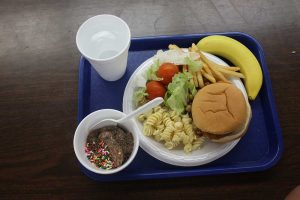By: Daniel Paez
Web Editor
When it is finally time for lunch, students rush from their classes to the cafeteria. There, they are able to make themselves a sandwich at the Panini station, grab a burger at the grill station, or choose from a variety of salads at the salad bar.┬Ā Many of the foods served may appear healthy, but they can be bad choices in large quantities.
ŌĆ£I really like the French onion soup, every time itŌĆÖs served in the cafeteria I get two bowls. I had no idea that one cup of it is almost 400 calories,ŌĆØ said sophomore Gustavo Mogollon.
This can be misleading to students who are trying to eat balanced meals. Foods like granola appears to be filled with the whole-grain goodness of oats, but it is what you do not see that can be harmful. Added fats and sugars that turned those healthful oats into granola make this a snack to enjoy in moderation.
Many foods that seem to be healthy alternatives might not be the best choice.┬Ā Pita chips are sometimes eaten as a substitute for regular potato chips. ┬Ā A bag of fried potato chips has 153 calories and an ounce of baked pita chips is 110 calories, according to Fatsecret.com.┬Ā If those pita chips were fried it would bump up the calorie count to 170 per ounce. The way different foods are cooked greatly affects the amount of calories it has, regardless if its seemingly ŌĆ£healthyŌĆØ appearance.
ŌĆ£We try to provide a wide variety of food choices for students.┬Ā All of the food we serve can be part of a balanced diet if eaten in moderation. There are students who think eating a certain type of food is beneficial for them, which may be true, but eating a plate full of it can be unhealthy,ŌĆØ said Food Service Director Mauricio Jaramillo.
The misconception of how nutritious food really is occurs commonly and can lead to poor eating choices.
A cheeseburger with French fries and ketchup amounts to around 500 to 700 calories.┬Ā Some students choose a different meal, rather than this one, because it appears it may not be the healthiest choice.┬Ā For example, a student might choose to eat a beef taco with chips, cheese, sour cream, and salsa on the side instead of the burger meal. In fact the taco meal, depending on the quantity, can amount to about 700 to 900 calories, making it a less healthy choice than the burger.
ŌĆ£In order to avoid this, we placed different colored dots that represent the nutritional information of the food on the labels.┬Ā So students can gauge how much of each food they should eat at a glance,ŌĆØ said Jaramillo.
This guideline program should assist students on making health-conscious decisions about the food they eat and answer any questions students might have about the health facts of the food they are served.





